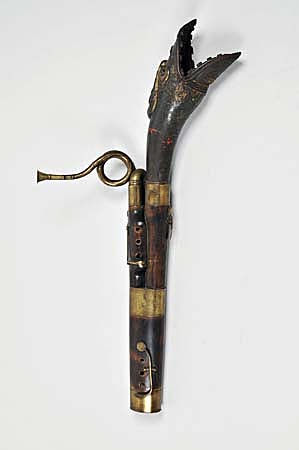
Owner: HWMC
Catalog # CL-AELV-077
Serpents
Russian Bassoon - Serpent Horn
Lyon, Paris
Dubois et Couturier
Wood (Maple), brass, polychromatic paint
ca. Late 1700’s or Early 1800’s
Height: 38 inches w/ MPC
Wind Instruments – Brasswinds – Serpents
A zoomorphic 3-keyed upright serpent horn (head like a “buccin”) that despite its name, “basson Russe” (often referred to as the “Russian bassoon”) it is neither Russian or a bassoon. It is an upright serpent instrument consisting of two wooden tubes joined together at the bottom and six-finger holes. This “Russian Bassoon” is made of maple with a metal serpent head and polychromatic painting attributed to being made by Dubois et Couturier, Lyon, Paris.
According to Oscar Abella: Possibly: J.J. Regibo of Lille, France, invented a three-part detachable upright serpent horn in 1780 or 1798 (still historically debatable). Lille, France is the capital of the Hauts-de-France region in northern France, near the border with Belgium. The second quarter of the 19th century became the golden age for the Russian bassoon, and they could be found at various manufactures in France, Belgium, Germany, and Italy. Another theory about its name, is that they were called a ‘Russian’ bassoon instead of ‘Prussian’ bassoon, due to a spelling mistake, as they were used in the Napoleonic campaigns at Prussia. Still another theory is that they were made by Rust, one of the first manufacturers in Lyon, France, followed by Dubois et Couturier, and the pronunciation of Rust was confused with the French pronunciation of ‘Russian’ (in French ‘Russe’ means Russian).
Resource: Oscar Abella | Instruments
